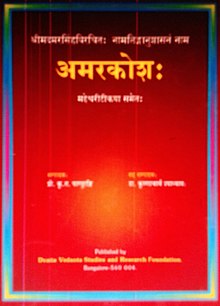This is an old revision of this page, as edited by Utcursch (talk | contribs) at 15:24, 8 February 2018 (rv: Schwa deletion in Indo-Aryan languages). The present address (URL) is a permanent link to this revision, which may differ significantly from the current revision.
Revision as of 15:24, 8 February 2018 by Utcursch (talk | contribs) (rv: Schwa deletion in Indo-Aryan languages)(diff) ← Previous revision | Latest revision (diff) | Newer revision → (diff)| This article needs additional citations for verification. Please help improve this article by adding citations to reliable sources. Unsourced material may be challenged and removed. Find sources: "Amarasimha" – news · newspapers · books · scholar · JSTOR (February 2017) (Learn how and when to remove this message) |

Amara Sinha (or Amara Simha, IAST: Amarasiṃha) (c. CE 375) was a Sanskrit grammarian and poet, of whose personal history hardly anything is known. He is said to have been "one of the nine gems that adorned the throne of Vikramaditya," and according to the evidence of Xuanzang, this is the Chandragupta Vikramaditya (Chandragupta II) who flourished about CE 375. Other sources describe him as belonging to the period of Vikramaditya of 7th century. Most of Amarasiṃha's work was destroyed, with the exception of the celebrated Amara-Kosha (IAST: Amarakośa) (Treasury of Amara). The first reliable mention of the Amarakosha is in the Amoghavritti of Shakatayana composed during the reign of Amoghavarsha (814-867CE)
The Amarakosha is a vocabulary of Sanskrit roots, in three books, and hence sometimes called Trikanda or the "Tripartite". It is also known as "Namalinganushasana". The Amarakosha contains 10,000 words, and is arranged, like other works of its class, in metre, to aid the memory.
The first chapter of the Kosha was printed at Rome in Tamil character in 1798. An edition of the entire work, with English notes and an index by HT Colebrooke appeared at Serampore in 1808. The Sanskrit text was printed at Calcutta in 1831. A French translation by ALA Loiseleur-Deslongchamps was published at Paris in 1839. B. L. Rice compiled the text in Kannada script with meanings in English and Kannada in 1927.
References
- ^ "Amara-Simha" in Chambers's Encyclopædia. London: George Newnes, 1961, Vol. 1, p. 311.
- ^ Chisholm 1911.
- ^ Amarakosha compiled by B. L. Rice, edited by N. Balasubramanya, 1970, page X
- Mirashi, Vasudev Vishnu (1975). Literary and Historical Studies in Indology. Motilal Banarsidass. pp. 50–51. ISBN 9788120804173.
- Mukherjee, Sujit (1998). A Dictionary of Indian Literature: Beginnings-1850. Orient Blackswan. p. 15. ISBN 9788125014539. Retrieved 6 July 2017.
- Rice, Benjamin Lewis (1927). Amarakōśa vemba nāmaliṅgānuśāsanavu, Iṅglish Kannaḍa artha mattu padagaḷa paṭṭi sahita. Asian Educational Services. ISBN 9788120602601.
Attribution:
 This article incorporates text from a publication now in the public domain: Chisholm, Hugh, ed. (1911). "Amara Sinha". Encyclopædia Britannica. Vol. 1 (11th ed.). Cambridge University Press. p. 781.
This article incorporates text from a publication now in the public domain: Chisholm, Hugh, ed. (1911). "Amara Sinha". Encyclopædia Britannica. Vol. 1 (11th ed.). Cambridge University Press. p. 781.